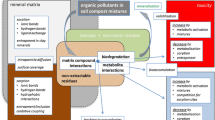Abstract
Two composting systems were compared on a laboratory scale as a bioredediation technology for degradation or immobilization of 2,4,6-trinitrotoluene (TNT) in contaminated soils. The first compost was aerated from the beginning whereas the second compost was only aerated after an anaerobic prephase of 65 days. In the first compost system the TNT concentration declined rapidly by 92% but, at the end, TNT could be partially recovered. During the anaerobic prephase of the second compost system, TNT was almost completely converted to aminodinitrotoluenes, which during the subsequent aeration almost entirely disappeared. In addition, the second compost generated less toxic material than the first one as confirmed by inhibition of bioluminescence ofVibrio fischeri. These data show that microbiological TNT-degradation systems can be successfully designed which are prerequisite for an efficient bioremediation of contaminated soils.
Similar content being viewed by others
References
Beuth Verlag (1991) Normenausschuß Wasserwesen (NAW) im DIN Deutsches Institut für Normung e.V.
Bollag J-M, Myers C (1992) Detoxification of aquatic and terrestical sites through binding of pollutants to humic substances. Sci Total Environ 117/118:357–366
Boopathy R, Kulpa CF, Wilson M (1993) Metabolism of 2,4,6-trinitrotoluene (TNT) byDesulfovibrio sp. (B strain). Appl Microbiol Biotechnol 39:270–275
Boopathy R, Manning J, Montemagno C, Kulpa C (1994) Metabolism of 2,4,6-trinitrotoluene by aPseudomonas consortium under aerobic conditions. Curr Microbiol 28:131–137
Breitung J, Bruns-Nagel D, Löw Ev, Steinbach K, Kaminski L, Haas R, Gemsa D (1995) Mikrobielle Sanierung von 2,4,6-Trinitrotoluol (TNT) kontaminierten Böden. UWSF-Z. Umweltchem. Ökotox. 7:195–200
Fernando T, Bumpus JA, Aust SD (1990) Biodegradation of TNT (2,4,6-trinitrotoluene) byPhanarochaete chrysosporium. Appl Environ Microbiol 56:1666–1671
Helling CS, Krivonak AE (1978) Physiochemical characteristics of bound dinitroaniline herbicides in soil. J Agric Food Chem 26:1156–1163
Hsu TS, Bartha R (1974) Biodegradation of chloroaniline humus complexes in soil and in culture solution. Soil Sci 118:213–219
Isbister JD, Anspach GL, Kitchens JF, Doyle RC (1984) Composting for decontamination of soils containing explosives. Microbiologica 7:47–73
Kaplan DL, Kaplan AM (1982) Thermophilic biotransformations of 2,4,6-trinitrotoluene under simulated composting conditions. Appl Environ Microbiol 44:757–760
Klibanov AM, Alberti BN, Morris J, Felshin LM (1980) Enzymatic removal of toxic phenols and anilins from waste waters. J Appl Biochem 2:414–421
Michels J, Gottschalk G (1994) Inhibition of the lignin peroxidase ofPhanarochaete chrysosporium by hydroxylamino-dinitrotoluene, and early intermediate in the degradation of 2,4,6-trinitrotoluene. Appl Environ Microbiol 60:187–194
Osmon JL, Andrews CC (1978) The biodegradation of TNT in enhanced soil and compost systems. (U.S. Army Armament Research and Development Command, ARLCD-TR-77032, Dover, N.J. Technical Information Service Publication no. ADE 400073) National Technical Information Service, Springfield. Va
Parris GE (1980) Covalent binding of aromatic amines to humanes. 1. Reactions with carbonyls and quinons. Environ Sci Technol 14:1099–1106
Preuss A, Fimpel J, Diekert G (1993) Anaerobic transformation of 2,4,6-trinitrotoluene (TNT). Arch Microbiol 159:345–353
Shindo H, Huang PM (1984) Catalytic effects of manganese (IV), iron (III), aluminum and silicon oxide on the formation of phenolic polymers. Soil Sci Soc Am J 48:927–934
Vorbeck C, Lenke H, Fischer P, Knackmus H-J (1994) Identification of a Hydride-Meisenheimer complex as a metabolite of 2,4,6-trinotrotoluene by aMycobacterium strain. J Bacteriol 176:932–934
Williams RT, Ziegenfuss PS, Sisk WE (1992) Composting of explosives and propellant contaminated soils under thermophilic and mesphilic conditions. J Ind Microbiol 9:137–144
Ziechmann W (1977) Zwischenmolekulare Kräfte und die Struktur von Huminstoffen. Z Pflanzenernähr Bodenkd 140:151–157
Author information
Authors and Affiliations
Rights and permissions
About this article
Cite this article
Breitung, J., Bruns-Nagel, D., Steinbach, K. et al. Bioremediation of 2,4,6-trinitrotoluene-contaminated soils by two different aerated compost systems. Appl Microbiol Biotechnol 44, 795–800 (1996). https://doi.org/10.1007/BF00178621
Received:
Accepted:
Issue Date:
DOI: https://doi.org/10.1007/BF00178621




